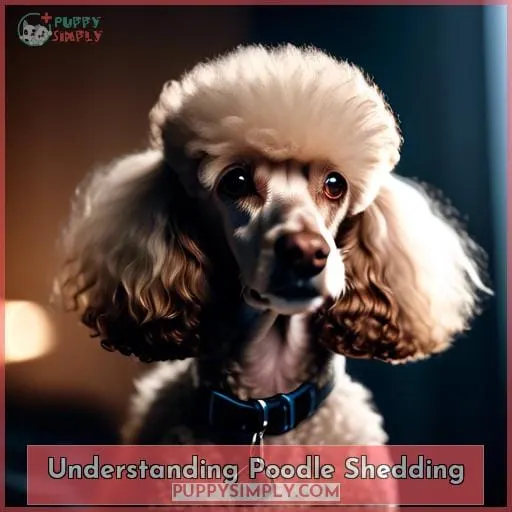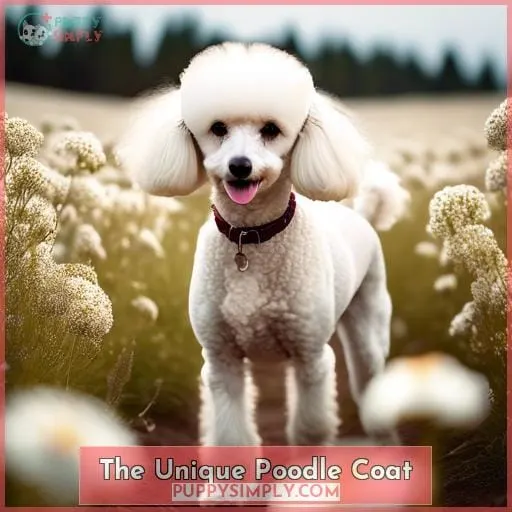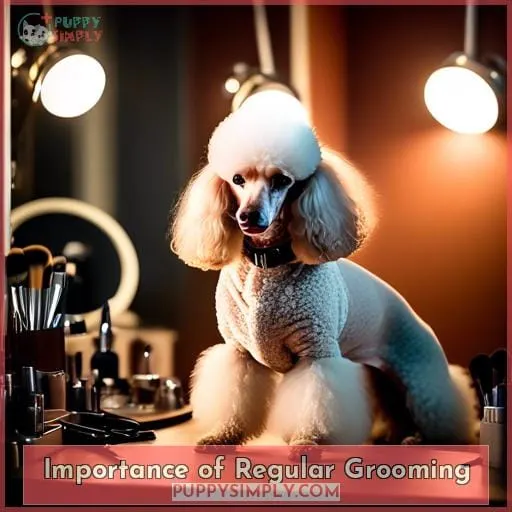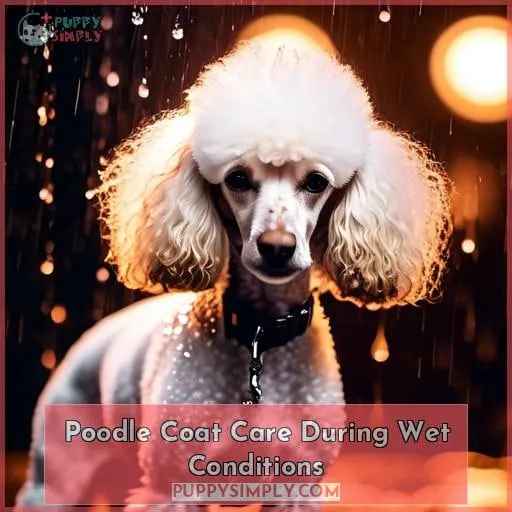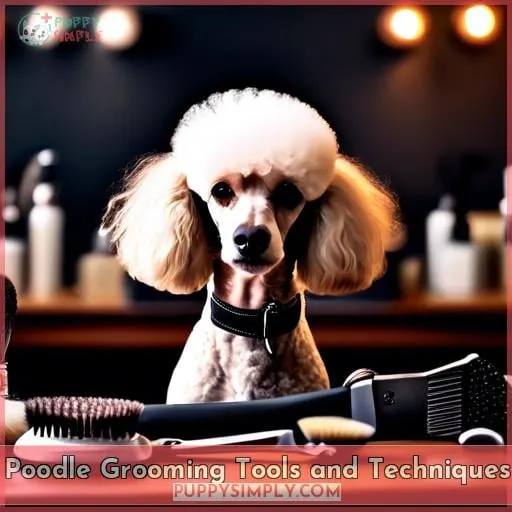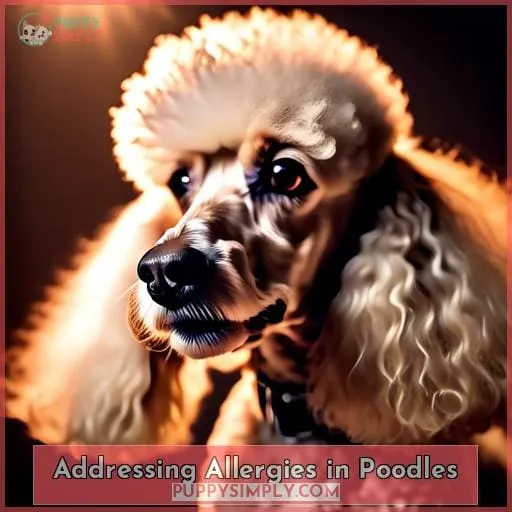This site is supported by our readers. We may earn a commission, at no cost to you, if you purchase through links.
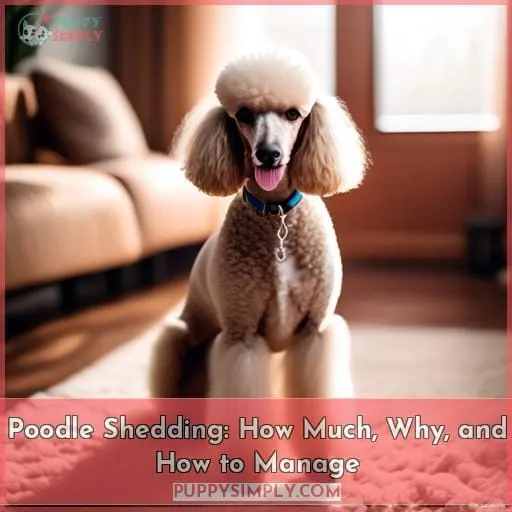 Picture this: a living room covered in dog hair, and a frustrated owner vacuuming endlessly.
Picture this: a living room covered in dog hair, and a frustrated owner vacuuming endlessly.
Now, imagine a home with a poodle, where shedding is a non-issue.
In this article, we’ll delve into the world of poodle shedding, exploring:
- Why poodles shed
- How much they shed
- Most importantly, how to effectively manage their shedding
We’ll uncover the secrets to keeping your home hair-free and your poodle looking their best.
Table Of Contents
- Key Takeaways
- Understanding Poodle Shedding
- The Unique Poodle Coat
- Importance of Regular Grooming
- Diet and Poodle Coat Health
- Regular Veterinary Checkups for Coat Health
- Poodle Coat Care During Wet Conditions
- Poodle Grooming Tools and Techniques
- Addressing Allergies in Poodles
- Exercise and Poodle Coat Health
- Poodles as Pets for Allergy Sufferers
- Frequently Asked Questions (FAQs)
- How often should a poodle puppy be groomed compared to an adult poodle?
- What are the key differences between the grooming requirements of a toy poodle and a standard poodle?
- Are there any specific grooming techniques or tools that are particularly effective for poodles with curly coats?
- What are the most common skin conditions that can affect poodles and how do they impact their shedding patterns?
- Are there any health conditions that are more prevalent in poodles and can lead to increased shedding?
- Conclusion
Key Takeaways
- Poodles shed less noticeably due to their curly coat that traps loose hair and longer shedding cycles.
- Poodles are often considered hypoallergenic because they shed less dander and hair, but it’s important to note that no dog is entirely allergen-free.
- Regular grooming, including daily brushing, bathing every 3-4 weeks, and professional grooming every 4-6 weeks, is essential for managing shedding and maintaining coat health in poodles.
- Poodle mixes inherit low-shedding traits and are often suitable for allergy sufferers, with reduced dander and hair, and a lower likelihood of causing allergic reactions.
Understanding Poodle Shedding
Poodles shed, but you’ll hardly notice because their curly coat traps loose hair.
Unlike breeds with fur that sheds seasonally, poodles have hair that grows continuously and gets caught in their curls, leading to minimal shedding throughout the year.
Shedding Frequency
When it comes to shedding, you’ll be happy to know that poodles definitely shed less than most other dog breeds.
Their shedding cycles are longer, and their curly coat traps loose hair, preventing it from flying around your home.
This makes them a great choice for allergy sufferers or those who simply don’t want to deal with a lot of dog hair.
Hair Vs Fur
Because poodles have hair instead of fur, it grows continuously and gets caught in surrounding hair, leading to minimal shedding.
This unique hair characteristic debunks the myth that poodles are hypoallergenic.
While they shed less than most breeds, they still require regular grooming to prevent mats and tangles.
Understanding the difference between hair and fur is crucial for proper poodle care and dispelling common misconceptions about their shedding habits.
Shedding and Allergies
Your poodle’s shedding can affect your allergies, so it’s important to understand the connection between the two.
Poodles are often considered hypoallergenic, meaning they shed less dander and hair, reducing allergy triggers.
If you have allergies, spend time with a poodle before committing to ensure minimal reactions.
Proper grooming and care can significantly control shedding, making poodles suitable pets for allergy sufferers.
The Unique Poodle Coat
Your poodle’s single coat is a unique feature that contributes to its low shedding.
Unlike other breeds with double coats, your poodle’s hair grows continuously and gets caught in surrounding hair, making shedding less noticeable.
Regular grooming is crucial to prevent matting and tangling, ensuring your poodle’s coat stays healthy and beautiful.
Single Coat Characteristics
While poodles shed less because of their unique single coat, its long growth cycle and ability to trap loose hair further contribute to their low-shedding nature.
- Long Growth Cycle: The extended growth phase of poodle hair allows it to stay attached to the skin longer, reducing shedding.
- Hair Trapping: Poodle coats act like nets, catching loose hair within their curls, preventing it from spreading around your home.
- Easy Maintenance: Single coats are easier to maintain than double coats, requiring less frequent brushing and grooming sessions.
Coat Color and Shedding
Despite the common misconception, your poodle’s coat color does not influence its shedding rate.
Shedding patterns are determined by coat genetics and overall health, not color.
While coat color genetics play a role in hair texture and length, all poodles share the same long hair growth cycle, resulting in minimal shedding regardless of coat color.
Regular veterinary checkups and health monitoring ensure your poodle’s shedding stays within normal limits.
Importance of Regular Grooming
Regular grooming is essential for managing poodle shedding, preventing matting, and maintaining coat health.
Brushing your poodle daily with a slicker brush and detangling comb helps remove loose hair and prevent tangles.
Bathing your poodle every 3-4 weeks with a gentle shampoo and conditioner helps keep their coat clean and free of debris.
Brushing and Detangling
By brushing and detangling your poodle’s coat regularly, you’ll help remove loose hair and prevent mats and tangles.
- Use a slicker brush to gently remove loose hair and prevent tangles.
- Use a comb to remove any mats or knots.
- Brush your poodle’s coat every day or every other day.
- Take your poodle to a professional groomer every 4-6 weeks for a thorough cleaning and haircut.
Bathing and Shampooing
You can continue caring for your poodle’s coat by:
- Bathing them every 3 to 6 weeks with a canine-formulated shampoo.
- Removing dirt, debris, and excess oil, keeping their coat clean and healthy.
Follow up with a conditioner to:
- Keep their coat soft and moisturized.
- Prevent dryness and irritation.
After bathing, dry their coat thoroughly with a towel or blow dryer:
- Ensure no moisture remains.
- Regular bathing maintains their skin’s natural oils, promoting a healthy and shiny coat.
Professional Grooming
With regular grooming, professional assistance can keep your poodle’s coat in tip-top condition.
They’ll use special techniques to:
- Remove dead hair
- Detangle knots
- Trim your poodle’s coat to a manageable length
Professional grooming can also help prevent shedding myths and shedding patterns by ensuring your poodle’s coat texture is healthy.
Diet and Poodle Coat Health
Nourishing your poodle with a balanced diet rich in Omega-3 and Omega-6 fatty acids supports healthy skin and a lustrous coat.
Furthermore, adding supplements like Native Pet’s Omega Oil to your poodle’s routine can further enhance their skin and hair health.
Balanced Diet for Skin and Fur
To maintain your poodle’s lustrous coat:
- Feed them a balanced diet rich in omega-3 and omega-6 fatty acids.
- These fatty acids help nourish the skin and promote healthy hair growth.
Consider supplementing their diet with:
- Fish oil
- Flaxseed oil
For an extra boost of omega-3s.
Role of Supplements
Supplements enhance your Poodle’s diet to promote healthy skin and coat.
Omega-3 and Omega-6 fatty acids nourish the skin and fur, reducing dryness and flakiness.
Biotin and zinc support strong hair growth and prevent breakage.
Vitamin E acts as an antioxidant, protecting the coat from damage caused by free radicals.
Consult your veterinarian before introducing supplements to ensure proper dosage and avoid potential interactions with medications.
Long-term benefits include a lustrous, tangle-free coat and reduced shedding.
Choose supplements from reputable sources to guarantee quality and effectiveness.
Regular Veterinary Checkups for Coat Health
Regular veterinary checkups are essential for maintaining your poodle’s coat health.
Parasites, skin infections, and hormonal imbalances can all lead to increased shedding.
Your vet can help you identify and treat any underlying issues that may be causing your poodle to shed more than normal.
Parasitic Infestations and Skin Infections
Following a balanced diet, regular veterinary checkups are crucial.
Identifying and addressing parasitic infestations and skin infections can lead to increased shedding.
Preventative measures, such as flea and tick control, are essential for maintaining skin health and preventing fungal infections.
Hygiene practices, including regular bathing and grooming, help control mites.
Bacterial treatments can address skin infections, while parasitic control measures protect against ticks.
These proactive steps ensure your poodle’s coat remains healthy and minimizes shedding.
Hormonal Disorders and Shedding
Watch out for hormonal imbalances that can trigger excessive shedding in your poodle.
Hormonal disorders like Cushing’s disease and hypothyroidism can disrupt the normal hair growth cycle, leading to abnormal shedding.
If you notice sudden changes in your poodle’s shedding pattern, it’s crucial to schedule a veterinary checkup.
Diagnostic tests will help identify the underlying hormonal imbalance, and treatment options may include medication, lifestyle adjustments, or a combination of both.
Early intervention can help manage shedding and promote overall pet wellness.
Poodle Coat Care During Wet Conditions
When your poodle’s coat is wet, it’s more prone to tangles and matting.
To prevent this:
- Towel-dry your poodle thoroughly after bathing or swimming.
- Brush their coat to remove any remaining moisture and loose hair.
Handling Wet Coats
When your poodle’s coat gets drenched, take action to dry and brush it promptly.
Towel-drying methods and air-drying techniques work wonders for absorbing moisture and preventing musty odors.
If you’re in a humid environment, consider coat blow-drying to remove excess water and maintain coat health.
Protecting your poodle’s coat from moisture and dampness is key to preventing skin irritation and coat damage.
Drying and Brushing Post-Bathing
After the bath, thoroughly dry your poodle’s coat with a towel or dryer on a low heat setting.
Use a brush designed for poodles to gently remove tangles, starting from the head and working your way down.
Finish with a leave-in conditioner to keep the coat soft and manageable.
Regular post-bath grooming will prevent mats and tangles, ensuring your poodle’s coat stays healthy and beautiful.
Poodle Grooming Tools and Techniques
To care for your poodle’s coat, you’ll need a few essential tools:
- A slicker brush and comb will help you remove tangles and mats.
- A pair of grooming scissors will help you trim the coat and keep it looking neat.
Daily brushing is essential to prevent mats and tangles. You should bathe your poodle every 1-2 weeks to keep their coat clean and healthy.
Essential Grooming Tools
To groom your poodle effectively, you’ll need a few essential tools:
- A high-quality slicker brush to remove loose hair and prevent mats.
- A metal comb for detangling and removing debris.
- Nail clippers to trim their nails regularly.
- Rounded-tip scissors for trimming around their eyes and paws.
- Shampoo and conditioner specifically designed for poodles to keep their coat clean and soft.
These tools will help you maintain your poodle’s coat and keep them looking their best.
Grooming Techniques for Poodles
With the right tools and techniques, you can keep your poodle’s coat healthy and beautiful.
-
Brush daily:
- Use a slicker brush to remove loose hair and prevent tangles.
- For curly coats, use a wide-toothed comb.
-
Trim regularly:
- Have your poodle’s coat trimmed every 4-6 weeks to keep it short and manageable.
-
Bathe as needed:
- Bathe your poodle every 6-8 weeks or as needed with a gentle shampoo and conditioner.
-
Address seasonal shedding:
- Brush your poodle more frequently during shedding season to remove loose hair.
-
Protect from humidity:
- Keep your poodle’s coat dry in humid weather to prevent mats and tangles.
Addressing Allergies in Poodles
If you’re allergic to dogs, you may wonder if a poodle is the right breed for you.
Let’s get straight to the point: poodles are considered hypoallergenic, meaning they’re less likely to trigger your allergies.
But it’s important to remember that no dog is 100% hypoallergenic.
Identifying Allergic Reactions
Since Poodles are often touted as hypoallergenic, it’s essential to recognize signs of allergic reactions if you already have allergies or are considering getting one.
Monitor for symptoms like sneezing, itchy eyes, coughing, and skin irritation.
If you suspect an allergy, consult an allergist for testing.
Once identified, manage reactions with medication, reduce allergen exposure, and make lifestyle adjustments.
Prevention strategies include regular grooming and keeping your home clean.
Understanding and addressing allergies ensures a harmonious coexistence with your beloved Poodle.
Allergies and Coat Health
Frequently addressing allergies in your poodle can improve their coat health and overall well-being.
Misconceptions about poodle shedding and coat care can lead to improper management of allergies, affecting your pet’s comfort and appearance.
Understanding your poodle’s unique coat and implementing effective coat care tips can help manage allergies and maintain a healthy, lustrous coat.
Exercise and Poodle Coat Health
Regular exercise stimulates blood circulation, which nourishes hair follicles and keeps your poodle’s coat healthy.
Mental stimulation prevents excessive licking and chewing on the coat, which can damage the hair.
Exercise and mental stimulation are essential for your poodle’s overall health and coat care.
Physical Activity and Blood Circulation
Physical activity and blood circulation impact your Poodle’s coat health.
Exercise stimulates canine circulation, sending nutrient-rich blood to hair follicles, promoting a healthy coat.
Active Poodles have lustrous, strong fur.
Engage your Poodle in activities like brisk walks, fetch, or swimming for optimal coat health.
Movement nourishes hair follicles, resulting in a vibrant, healthy coat that radiates health.
Mental Stimulation and Coat Health
Your Poodle’s mental health also plays a role in its coat health.
When your Poodle is mentally stimulated and content, it’s less likely to engage in behaviors that can damage its coat, such as excessive licking or chewing.
- Engage your Poodle in stimulating activities like fetch, tug-of-war, and scent games.
- Use enrichment techniques such as puzzle toys and interactive feeders to keep your Poodle’s mind active.
- Provide your Poodle with plenty of chew toys to satisfy its natural chewing instinct and prevent it from chewing on its coat.
- Ensure your Poodle gets plenty of exercise to tire it out both physically and mentally.
- Make sure your Poodle has a safe and comfortable space to relax and de-stress.
Poodles as Pets for Allergy Sufferers
If you have allergies but still want a furry friend, poodles might be the choice for you.
Poodles are a hypoallergenic breed, so they’re less likely to cause allergic reactions.
They also don’t shed much, so you won’t have to worry about finding fur all over your house.
Hypoallergenic Nature of Poodles
Let’s dive into the truth about poodles’ hypoallergenic reputation and explore how they can make great companions for allergy sufferers.
While no dog is 100% allergen-free, poodles come pretty close.
Proper management strategies and allergen reduction techniques can make living with a poodle a pleasant experience for those with allergies.
Allergy testing can help you understand your specific triggers and determine if a poodle is the right fit for you.
Poodle Mixes and Allergies
Mixing poodles with other breeds may slightly reduce their hypoallergenic properties, but they’re still a great choice for allergy sufferers.
Labradoodles and Golden-doodles, popular poodle mixes, inherit the low-shedding, allergy-friendly traits of poodles.
Poodle mixes may cause fewer allergic reactions compared to other breeds, offering relief to sensitive individuals.
Crossbreeding poodles dilutes the shedding tendency, resulting in less dander and hair in your living space.
Allergic reactions to poodle mixes are rare, making them suitable companions for allergy-prone families.
Embrace the joys of pet ownership without compromising your well-being; poodle mixes offer love and companionship without triggering allergies.
Frequently Asked Questions (FAQs)
How often should a poodle puppy be groomed compared to an adult poodle?
Grooming needs vary with age.
As a puppy, your poodle’s coat requires more frequent attention to prevent mats and tangles.
Daily brushing and occasional professional grooming are key to maintaining a healthy, beautiful coat throughout their life.
What are the key differences between the grooming requirements of a toy poodle and a standard poodle?
Toy poodles, like miniature dancers, require daily pirouettes with the brush to maintain their graceful coats.
Standard poodles, akin to shaggy storytellers, need regular detangling sessions to keep their epic tales from becoming tangled knots.
Are there any specific grooming techniques or tools that are particularly effective for poodles with curly coats?
Curly-coated poodles require specific grooming techniques to maintain healthy, tangle-free coats.
Regular brushing with a slicker brush and wide-toothed comb helps remove dead hair and prevent matting.
Additionally, regular trims by a professional groomer are essential to keep the coat manageable and stylish.
What are the most common skin conditions that can affect poodles and how do they impact their shedding patterns?
Poodles, with their curly coats, can suffer from skin conditions like hot spots, eczema, and allergies.
These conditions can cause excessive shedding, discomfort, and even infection.
Regular grooming and vet checkups are crucial for keeping your poodle’s skin healthy and minimizing shedding.
Are there any health conditions that are more prevalent in poodles and can lead to increased shedding?
Yes, certain health conditions common in poodles can increase shedding.
Address skin allergies promptly to prevent coat damage and discomfort, leading to excessive shedding.
Regular vet visits are crucial for overall health and coat care.
Conclusion
As a poodle owner, you’ve experienced the joy of living with a low-shedding breed.
With the right grooming routine and care, you can minimize shedding even further, creating a harmonious home for both you and your beloved poodle.
Embrace the unique characteristics of your poodle’s coat and enjoy the companionship of a pet that won’t leave a trail of hair behind.

